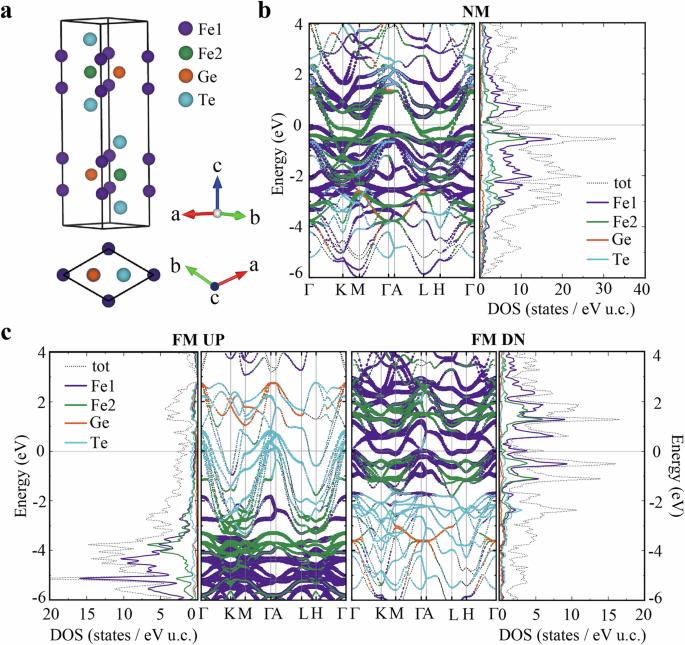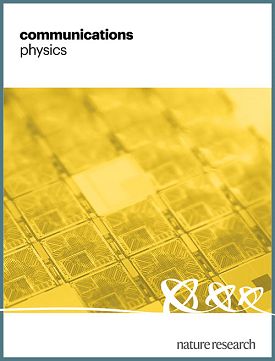Mechanism of magnetic phase transition in correlated magnetic metal: insight into itinerant ferromagnet Fe3−δGeTe2
IF 5.8
1区 物理与天体物理
Q1 PHYSICS, MULTIDISCIPLINARY
引用次数: 0
Abstract
Developing a comprehensive magnetic theory for correlated itinerant magnets poses challenges due to the difficulty in reconciling both local moments and itinerant electrons. In this work, we investigate the microscopic process of magnetic phase transition in ferromagnetic metal Fe3−δGeTe2. We find that Hund’s coupling is crucial for establishing ferromagnetic order. During the ferromagnetic transition, we observe the formation of quasiparticle flat bands and an opposing tendency in spectral weight transfer, primarily between the lower and upper Hubbard bands, across the two spin channels. Moreover, our results indicate that one of the inequivalent Fe sites exhibits Mott physics, while the other Fe site exhibits Hund’s physics, attributable to their distinct atomic environments. We suggest that ferromagnetic order reduces spin fluctuations and makes flat bands near the Fermi level more distinct. The hybridization between the distinctly flat bands and other itinerant bands offers a possible way to form heavy fermion behavior in ferromagnets. The complex interactions of competing orders drive correlated magnetic metals to a new frontier for discovering outstanding quantum states. Understanding magnetism in correlated itinerant systems has been an important yet challenging task due to the complex interplay among Hund, Mott, and Kondo physics. In this work, by using DFT + DMFT, the authors reveal the mechanism of the magnetic phase transition and the heavy-fermion behavior in low temperatures in a ferromagnetic metal, shedding light on the roles of the above three factors.

相关磁性金属的磁性相变机制:对巡回铁磁体 Fe3-δGeTe2 的启示
由于难以调和局部磁矩和巡回电子,开发相关巡回磁体的综合磁性理论面临挑战。在这项工作中,我们研究了铁磁性金属 Fe3-δGeTe2 中磁性相变的微观过程。我们发现,Hund 耦合是建立铁磁秩序的关键。在铁磁转变过程中,我们观察到准粒子平带的形成,以及光谱重量转移的相反趋势,主要是在两个自旋通道的下哈伯德带和上哈伯德带之间。此外,我们的研究结果表明,其中一个不等价铁位点表现出莫特物理,而另一个铁位点则表现出亨德物理,这归因于它们不同的原子环境。我们认为,铁磁秩序减少了自旋波动,使费米水平附近的平坦带更加明显。明显的平坦带和其他巡回带之间的杂化为在铁磁体中形成重费米子行为提供了可能的途径。竞争阶的复杂相互作用将相关磁性金属推向了发现杰出量子态的新前沿。由于亨德、莫特和近藤物理学之间复杂的相互作用,理解相关巡回系统中的磁性一直是一项重要而又具有挑战性的任务。在这项工作中,作者利用 DFT + DMFT 揭示了铁磁金属在低温下的磁性相变机制和重费米子行为,阐明了上述三个因素的作用。
本文章由计算机程序翻译,如有差异,请以英文原文为准。
求助全文
约1分钟内获得全文
求助全文
来源期刊

Communications Physics
Physics and Astronomy-General Physics and Astronomy
CiteScore
8.40
自引率
3.60%
发文量
276
审稿时长
13 weeks
期刊介绍:
Communications Physics is an open access journal from Nature Research publishing high-quality research, reviews and commentary in all areas of the physical sciences. Research papers published by the journal represent significant advances bringing new insight to a specialized area of research in physics. We also aim to provide a community forum for issues of importance to all physicists, regardless of sub-discipline.
The scope of the journal covers all areas of experimental, applied, fundamental, and interdisciplinary physical sciences. Primary research published in Communications Physics includes novel experimental results, new techniques or computational methods that may influence the work of others in the sub-discipline. We also consider submissions from adjacent research fields where the central advance of the study is of interest to physicists, for example material sciences, physical chemistry and technologies.
 求助内容:
求助内容: 应助结果提醒方式:
应助结果提醒方式:


